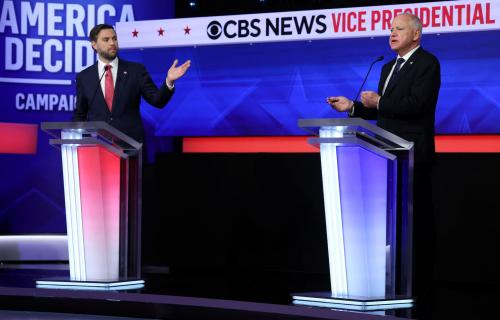Editor’s Note: As part of the 2014 Midterm Elections Series, we’ve asked experts from the ten states with competitive Senate races to answer six questions in a spotlight on each race, providing perspective on the dynamics in the state as we head toward Election Day. In this post, Tracy Osborn unpacks the key issues in the Iowa Senate race between Joni Ernst and Bruce Braley.
1. What have been the three key issues in this year’s Senate race?
The three key issues in the 2014 Iowa Senate race have been the Affordable Care Act, the economy, and abortion. If there is one national issue in the 2014 Senate races, the ACA is likely it. In Iowa, the issue is important as a part of the bigger health care debate, but it lacks some of the fire present in other states where the governor has refused Medicaid expansion in opposition to Washington (Iowa’s Republican governor, Terry Branstad, supported Medicaid expansion; Branstad is also up for re-election this November). Despite Iowa’s relatively high economic performance relative to other states, manufacturing job losses and the Farm Bill remain important in Iowa voters’ minds. Finally, in the last few weeks of the election, abortion has risen as an election issue in state debates and campaign trail speeches.
2. How have the candidates handled these issues and which candidate has been the strongest on those issues?
Republican candidate Joni Ernst made an early splash with two key ads. In one, she told voters she’d apply her Iowan hog-castrating skills to Washington; in the other, she shot the Affordable Care Act with a gun from her purse. These two ads have made her positions on at least one key issue (the ACA) quite clear for Iowans.
Democratic candidate Bruce Braley’s vote on the ACA is a matter of House record, but Braley has clarified his opposing position on gun control with further ad buys. On the economy, both candidates have used ads, the debates, and Iowa retail politics to blame the other for Iowa job losses. Braley likely holds the upper hand on abortion; Ernst’s past actions in the Iowa state legislature indicate a strong pro-life stance that contrasts with some of Ernst’s recent statements on fetal rights and contraception. Braley has been highlighting abortion as a key issue more in the past few weeks.
On the other hand, Ernst may be winning the economic issue war. Lowering taxes and pork spending are go-to issues for her speeches, and she holds the advantage of being able to play up her Washington outsider status.
3. Have any other issues resonated specifically with key demographic groups or interests and what are the implications for the race?
Braley’s decision to capitalize on the abortion issue may be due to the importance of women voters in the midterm election. The Iowa race is currently such a toss-up that the direction of a potential gender gap could decide it. Typically, the gender gap benefits Democratic candidates, and currently Braley has a significant lead among likely women voters in the polls. Iowa voters are aware, however, that Iowa is one of only two remaining states never to elect a woman as governor or U.S. Senator. Ernst has also played up her motherhood in articulating her policy positions. If, as a woman candidate, she were to divert even some of the Democratic gender gap, it could spell significant trouble for Braley.
4. How have outside surrogates, SuperPACs, or other outside spending played a role in the race?
The list of political committees spending money in the Iowa Senate race is substantial for both Ernst and Braley—a total of nearly $55 million in 2014 so far. According to the Center for Responsive Politics, SuperPAC NextGen Climate Action Committee has run over $4 million in negative ads against Republican Joni Ernst. In turn, American Crossroads has spent more than $3.7 million in negative ads against Braley. The result has been a significant and starkly negative multimedia ad war across Iowa for the last three months. Both candidates have used these outside ad buys as fodder against their opponent in the Senate debates.
5. Midterms are often characterized by low turnout. What are your expectations about voter apathy/engagement in this race?
Though midterm turnout is lower compared to presidential election years, Iowa has one of the highest turnout rates in the nation compared to other states. Thus, even in a midterm election, Iowa can expect relatively high turnout, especially from registered partisans. For the political parties, then, the strategy in the state is to entice party voters to commit through early voting which began on September 25. In the past, Democrats have won early voting in Iowa, but Republicans have committed more resources this year to cutting Democrats’ early vote advantage. The remaining fight is for independent voters, who turnout at lower rates than partisans, but who comprise a bigger part of the Iowa electorate than registered Democrats or registered Republicans. Iowa allows same-day voter registration, which gives no-party voters inclined to wait until Election Day more time to make up their minds.
6. National media attention to this Senate race has been substantial. What important aspects have the media overlooked that may surprise outside observers on Election Day?
There are two important aspects to the race in Iowa. First, Iowa is a true toss-up, and not just in actual poll numbers. In the last 30 years, Iowa has had Democratic and Republican governors and Democratic and Republican Senators. Both the retiring Democrat Harkin, and Grassley, the Republican, handily won their most recent Senate campaigns by similar percentages. Put simply, a lot of Iowa voters like both Democrats and Republicans, and it can be difficult to predict which party’s candidate might resonate with open-minded voters. Both Braley and Ernst have spent a fair amount of media money and talking time selling their “Iowa-ness” to voters to try to overcome this problem. Each candidate is also making a significant effort to shake hands and see as many Iowa crowds as possible in the last week in order to touch base with the ordinary Iowan before the election.
Second (and somewhat contradictory), the Iowa Senate race could really come down to how the national tide or the more local tide affects the Senate midterm. Republican motivation and Democratic frustration in the state may shape voter turnout just enough to influence the election outcome. The governor’s race in Iowa is not even close, but the Iowa state senate is hotly contested, and Republicans would love to take control of the Iowa State Senate along with Harkin’s former Senate seat.



Commentary
2014 Midterms: Key Issues in the Iowa Senate Race
October 30, 2014